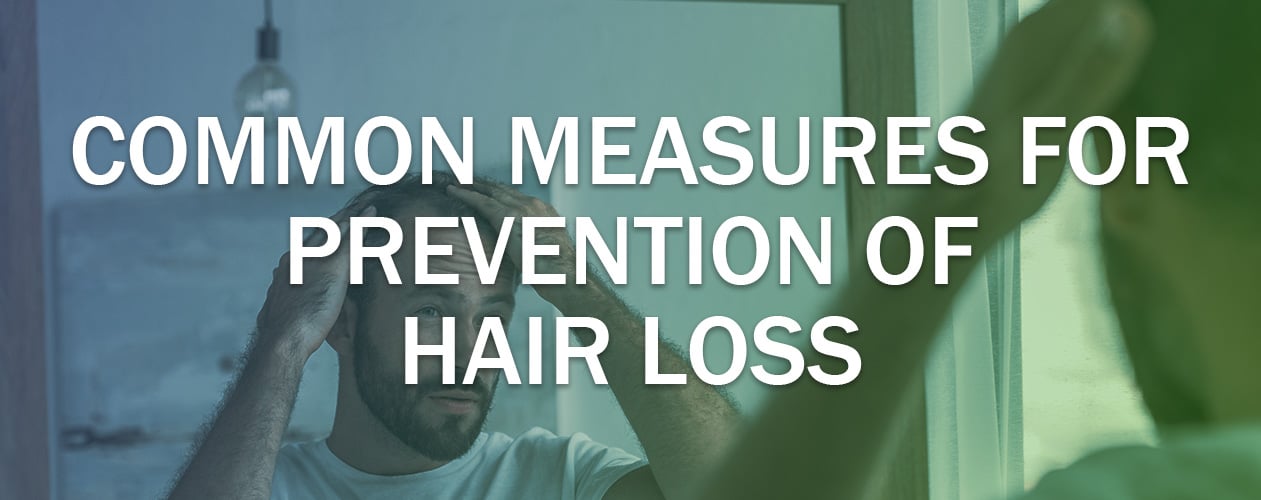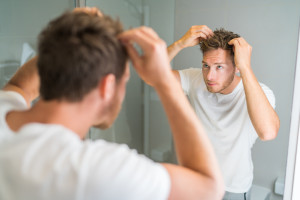Common Measures For Prevention Of Hair Loss

Background
Hair is an important part of a person’s physical appearance. The present cultural emphasis on youthful appearance has further strengthened the value of abundant hair.
If you have recently looked in the mirror to discover you have thinning, balding patches of hair or a receding hairline, you may be suffering from male pattern baldness or another condition that’s causing your hair loss. Hair loss is not entirely understood by researchers, though, so slowing balding and regenerating hair growth can sometimes be a guessing game. There are common measures for prevention of hair loss for young men who experience mild to severe hair loss. You should start by trying to understand the cause of your baldness to help you decide which treatment (or lifestyle changes) may work for you.
The available studies on baldness and perceived age have been conducted in younger and middle-aged men. As men age, the probability of visible AGA (androgenetic alopecia) increases. Accordingly, baldness is a more normative part of the physical appearance in elderly men and could hence be expected to affect perceived age to a lesser degree at older ages.
What is the prevalence of hair loss?
Hair loss is a universal problem. Androgenetic alopecia (AGA) is the most common type of hair loss in men. Androgenetic alopecia (AGA) more commonly known as male pattern baldness affects up to 50% of men worldwide. The disorder is more common in younger people than ever before according to recent statistics and 30 is the age where a man decides to do something about it. The statistics which have just been revealed by The Belgravia Centre, consider more than 10,000 men.
The results show there is an exponential rise in the number of male hair loss sufferers between the ages of 21 and 30 and thereafter patient numbers gradually decline with age. It is distinct (i.e., cosmetically significant) in more than 45% Caucasian men by the age of 49, and in 70% by the age of 79.
What is male pattern hair loss?
Male pattern hair loss or androgenetic alopecia is a common condition in which men experience thinning of the hair on the scalp. In some cases, this results in a receding hairline or balding on the top of the head.
The prognosis of androgenetic alopecia is not known. Some patients progress to the point where they lose almost all hair on the scalp. Others have a patterned or nonpatterned thinning but retain a considerable number of hairs on the scalp.5
Types of hair loss
The medical term for hair loss is alopecia and there are several different types of alopecia that affect men. Some of these types include:
- Androgenic Alopecia: This affects both men and women but is more common in men. This is also referred to as “male pattern baldness” and can affect men as early as their late teenage years or early twenties. Typically, this type of alopecia will produce a gradually receding hairline, which eventually results in a loss or thinning of most of the hair on the scalp. This is the most common type of alopecia that causes early hair loss.
- Involutional Alopecia: This is the most common form of baldness and is usually not a reason for concern, as this refers to normal hair loss with age.
- Alopecia Universalis: This condition causes hair over the entire body to fall out, including eyebrows, eyelashes, the hair on arms, legs, and the face, as well as the scalp.
The phases of your hair follicles rotate on different time intervals. Some follicles have shorter intervals than others, and research has never been able to identify the cause for the discrepancy in phase time periods. Sometimes, hair follicles prematurely reach the telogen phase, resulting in hair loss. In other cases, follicles may reach this resting phase and never return to the anagen phase, meaning there is no new hair growth after the hair falls out.
Certain factors may affect hair loss. Some of these include:
- Hormonal changes and imbalances: Hair loss is often associated with extreme hormonal changes or hormone imbalances, including abnormal androgen levels and more.
- Family History: Look at your father, grandfather or brothers on your paternal and maternal side. Often, balding is considered genetic.
- Stress: It’s no secret that stress can cause hair loss and an increase in the stress hormone cortisol may make you more likely to suffer from conditions like telogen effluvium, which causes more hairs than normal to fall out, or trichotillomania, a psychological condition in which a person pulls out their hair, like as a nervous (or stress-induced) habit.
- Illness: Some illnesses can cause your hair follicles to function improperly, such as thyroid conditions, lupus, anaemia, or diabetes. Fungal infections are commonly known to cause hair loss, though it is often temporary. Autoimmune diseases often cause hair loss as well.
Is it normal to lose hair on daily basis?
People have between 100,000 and 150,000 hairs on their head. The number of strands normally lost in a day varies but on average is 100. In order to maintain a normal volume, hair must be replaced at the same rate at which it is lost. The first signs of hair thinning that people will often notice are more hairs than usual left in the hairbrush after brushing or in the basin after shampooing. Styling can also reveal areas of thinning, such as a wider parting or a thinning crown.
However, some people tend to lose more hair than that which results in telogen effluvium. Telogen phase of the hair follicle growth cycle is the natural phase of scalp hair shedding. If hair follicles remain in the telogen phase for a longer period than usual, it is likely that the person will start shedding hair leaving the scalp exposed. Such a change can be brought about by triggers such as trauma, childbirth and even hormonal changes.
Stages of hair loss
There are many factors that affect the rate at which a man loses hair, but the reason they all tend to shed in this predictable pattern is simple. Male pattern hair loss is caused by hormones and genetic predisposition. After puberty, the level of testosterone increases. One of its derivatives, dihydrotestosterone (DHT), is a key ingredient in hair loss for men who have a family history of hair loss.
Well, the rate at which men lose hair varies enormously. Male hair loss can begin as early as puberty and while some men may shed rapidly in their 20’s up to a Type 3 or Type 4, others may have no detectable amount of hair loss until they are in their 50’s, only to advance to a Type 6 or Type 7 in just a few short years. Essentially, the scale is used to assess how advanced a man’s hair loss is, the higher the number, the more advanced the loss. And if you start to thin or recede early in life, there’s a good chance you’re destined to lose quite a bit of hair.
- Type I. Minimal hair loss;
- Type II. Insignificant hair loss at the temples;
- Type III. The first stage that requires treatment;
- Type III vertex. Receding hairline and thinning hair on the vertex;
- Type IV. A bigger pattern on the vertex and hairline;
- Type V. Patterns at both sites are bigger but a thin division line is still present;
- Type VI. The bridge is gone but several strands of short fine hair may remain;
- Type VII. The most severe form of hair loss. Little hair on the front or top of the head.
How to prevent hair loss?
- Watch what you eat. Lean protein found in fish, lean meats, and soy support hair growth, and nuts and seeds are packed with vitamin E and healthy fats to provide your hair with the oil it needs to stay soft and healthy. Even spices can help: adding cinnamon to your food can help provide the necessary oxygen and nutrients to your hair.
- Stay hydrated. Some 25% of your hair follicles are made of water and when you’re dehydrated, new follicles may be weak.
- Take your medicines. Next, to stress, genes, and medical issues, vitamin deficiency is a primary reason for hair loss in men. To help prevent balding, get enough vitamins from a well-rounded diet. Vitamin A is helpful in regulating the synthesis of retinoic acid in the hair follicles. Vitamin B can help you reduce your stress levels (a contributor to hair loss) while vitamins C, D, and E help your body maintain the necessary nutrients that it needs to remain healthy.
- Get an expert opinion. Ask a dermatologist how to prevent hair loss and more than likely he or she will tell you to be proactive and work to solve the issue before it starts or gets worse.
- Talk to your doctor about hair loss medications. When it comes to how to prevent balding, several medications and treatments are on the market that may slow or prevent hair loss in men.
- Manage stress. Some men may even stress so much about losing their hair that the stress they create leads to additional hair loss. High levels of stress can result in numerous medical hair loss conditions including telogen effluvium (a condition that essentially pushes your hair out of your head), trichotillomania (a man’s urge to pull his hair out of his scalp), and alopecia areata (where your immune system attacks the hair follicles).
- Limit your smoking and drinking. Smoking can be an issue because it impacts the blood flow to your hair follicles while drinking alcohol in excess can cause dehydration and nutritional deficiencies.
- Be active. Exercise is a proven stress reliever and promotes circulation and good health overall, which may encourage hair growth.
- Avoid high-heat hair styling tools. Using heat to style your hair leaves your hair follicle dehydrated and vulnerable to damage. Hairdryers, hair straighteners, and curling irons can all damage your hair over time.
- Don’t chemically treat or bleach your hair. Hair treatment chemicals cause sudden and irrevocable damage to hair follicles. If you’re concerned about hair loss, limit your use of dyes, highlights, peroxide treatments, and perms.
- Use a shampoo that’s mild and suited for your hair. The purpose of shampoo is to cleanse your hair of dirt and excess oil. But many commercial shampoos contain harsh ingredients. After just one use, they can strip your hair of the natural oil and fatty acids that make it strong and supple. Read the ingredients of your shampoo and purchase one that’s as close to all-natural as possible. Try switching up products if you’ve been losing excess hair.
- Use a soft brush made from natural fibres. Using a soft brush with fibres that are natural will promote healthy sebum (oil) levels on your hair. The keratin proteins in your hair are stacked like shingles on a roof, so brushing them gently in one direction, starting at the top and continuing through to the ends, will help smooth and condition your hair cuticle on a molecular level. Brushing hair daily can also help you avoid seeing hair clumps in your shower drain.
- Try low-level light therapy. Low-level light therapy promotes cell growth and repair. It’s been shown to promote hair growth in people with alopecia. This therapy can be prescribed by your doctor.
Home remedies for hair loss
If you’re concerned about hair loss, you may want to try a home remedy to see if you can stop your hair from falling out. It’s important to get diagnosed and find the underlying cause of your hair loss so that you can treat it appropriately.
- Supplements. Nutritional deficiencies can cause hair loss. Iron, zinc, niacin, selenium, vitamin D, and vitamin B-12 supplements can help your body produce hair that’s strong and healthy. Remember to only buy supplements from trusted sources, as they aren’t vetted by the Ministry of Health.
- Essential oils. Essential oils are aqueous extracts of powerful botanical ingredients. Essential oils can be mixed with carrier oils, like jojoba and almond oil, to create a treatment to stimulate hair growth. Some essential oils might make your hair grow stronger. Research on these essential oils is mostly anecdotal, but we are learning more about how they work.
- Scalp massage. Scalp massage has been shown to promote hair growth. By promoting circulation in the area of growth, your hair may grow more quickly if you gently massage your scalp every time you wash your hair.
- Diet. Your diet can influence hair loss. Eating a diet rich in antioxidants can help fight the signs of oxidative stress — environmental factors that damage hair follicles. Strawberries, blueberries, beans and legumes, spinach, and kale are all sources of antioxidants.
- Sugar, processed fats, preservatives, and alcohol can all contribute to oxidative stress. Keep this in mind if you’re looking to stop your hair from falling out.
Which are the approved drugs for hair loss?
The Medicines and Healthcare products Regulatory Agency has approved two drugs to treat male pattern baldness: Finasteride (Propecia) and Minoxidil (Rogaine). For both drugs, it may take up to a year to see results, and you’ll need to keep taking them to maintain the benefits.
- Minoxidil (Rogaine) is a non-prescription medication approved for male pattern baldness and alopecia areata. In a liquid or foam, it is rubbed into the scalp twice a day. Not all users will regrow hair. The longer the hair has stopped growing, the less likely minoxidil will regrow hair. Minoxidil is not effective for other causes of hair loss. Hair regrowth can take 1 to 6 months to begin. Treatment must be continued indefinitely. If the treatment is stopped, hair loss resumes. Any regrown hair and any hair susceptible to being lost, while Minoxidil was used, will be lost. Most frequent side effects are mild scalp irritation, allergic contact dermatitis, and unwanted hair in other parts of the body.
- Finasteride (Propecia) is a specific inhibitor of steroid Type II 5a-reductase, an intracellular enzyme that converts the androgen testosterone into 5a-dihydrotestosterone (DHT). DHT is a powerful hormone that causes hair follicles to miniaturize and eventually stop growing hair. Propecia (Finasteride) tablets are film-coated tablets for oral administration. Each tablet contains 1 mg of Finasteride. You may need to take Finasteride by mouth daily for three months or more before you see a benefit from taking it. Finasteride can only work over the long term if you continue taking it. If the drug has not worked for you within twelve months, further treatment is unlikely to be beneficial. If you stop taking Finasteride, you will probably lose the hair you have gained within 12 months of stopping treatment. You should discuss this with your doctor. Take Finasteride at the same time each day. Finasteride can be administered with or without meals. It is not indicated for women and is not recommended in pregnant women.
References
- Michael S., Judith A. Effects of Cranial and Facial Hair on Perceptions of Age and Person. The Journal of Social Psychology, 1991; DOI: 10.1080/00224545.1991.9713892;
- https://academic.oup.com/biomedgerontology/article/60/8/1077/545174;
- https://www.belgraviacentre.com/blog/hair-loss-more-common-in-young-men-than-ever-079/;
- Norwood OT. Male pattern baldness: classification and incidence. South Med J. 1975 Nov; 68(11):1359-65; PMID: 1188424;
- https://medbroadcast.com/condition/getcondition/alopecia;
- https://www.webmd.com/skin-problems-and-treatments/hair-loss/understanding-hair-loss-basics;
- Mysore V, Shashikumar BM. Guidelines on the use of finasteride in androgenetic alopecia. Indian J Dermatol Venereol Leprol. 2016 Mar-Apr;82(2):128-34.; PubMed PMID: 26924401; doi: 10.4103/0378-6323.177432;
- Mrinal Gupta and Venkataram Mysore. Classifications of Patterned Hair Loss: A Review. J Cutan Aesthet Surg. 2016 Jan-Mar; 9(1): 3–12. PMCID: PMC4812885. PubMed PMID: 27081243. DOI.4103/0974-2077.178536;
- https://www.healthline.com/health/how-to-prevent-hair-loss#athomeremedies;
- https://www.accessdata.fda.gov/drugsatfda_docs/label/2011/020788s018lbl.pdf.




